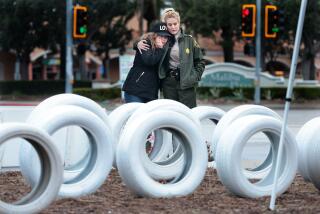Beware the narrow lanes of some Southland freeways
A good freeway design does not surprise or confuse people with the unexpected, but instead makes driving intuitive and obvious.
But some places in Southern California’s freeway system can give drivers a claustrophobic reaction, like walls closing in, and it isn’t the drivers’ imagination. In hundreds of locations the lanes of the interstate freeways unexpectedly narrow from the recommended national standard of 12 feet wide to something less.
Safety experts say narrower lanes compromise safety, though it’s a controversial issue that has received little attention or rigorous study.
I recently asked Caltrans how many miles of freeways here do not conform to the 12-foot standard. “We comply fully with all lane width criteria,” said California Department of Transportation spokesman Dennis Trujillo. Then, he later explained that all lanes less than 12 feet wide have gone through an administrative “exception process.”
Caltrans engineers, who would not speak for the record, said they had no idea how many miles of freeway lanes failed to conform to the 12-foot standard. The only public record of that is the State Highway Log Book.
On a recent afternoon, I inspected the log book and found scores and scores of road segments on the Santa Monica, Pasadena and San Diego freeways, among others, that have narrower than 12-foot-wide lanes. I asked Caltrans about just one example, a segment of the Long Beach Freeway near the Washington Avenue exit where the log book states three lanes occupy 28 feet, or an average of 9.3 feet per lane.
As drivers of the Long Beach Freeway know, this segment is usually jammed with big freight trucks making the run from the ports to the railroad yards in East Los Angeles. If there is anyplace where you don’t want lanes less than 10 feet wide, it is precisely here.
After a couple of days, Caltrans said the log book was in error and the Long Beach Freeway’s lanes were actually 12 feet wide. I considered going out with a tape measure to check but decided not to risk my life. I doubt that out of the millions of entries in the log book, I found the only example of Caltrans’ messed-up records.
Narrow lanes are often found on old freeways, such as the Pasadena, or on newer freeways where Caltrans has eliminated the shoulder and squeezed in an extra lane to increase the freeway’s capacity.
Are narrow lanes a safety hazard? A Caltrans engineer said the proper safety width was a “gray area,” but he added, “It isn’t really a significant change in safety when you go from 12 feet to 11 feet.”
Not so, says Gerson Alexander, formerly chief for human factors at the Federal Highway Administration for 16 years. He said narrow lanes compromise safety, and freeways where the lanes narrow are a particular concern. Many of the segments I found in Caltrans’ log book, assuming they were not all in error, indicate that lanes narrow suddenly and then revert back to 12 feet.
“It is the abrupt transitions that cause driver problems of perception and reaction,” Alexander said. “In roadway curves, width is even more of a factor.” He suggested that signs be put up if a road narrows to help drivers know where the road has changed.
Howard L. Anderson, former design chief at the Federal Highway Administration, called 12-foot-wide lanes “a good, safe lane that is ideal for mixed traffic where you have cars and trucks.” He noted that Arizona provides 13-foot-wide lanes for truck routes, which he called “highly desirable.” And he said local decisions to squeeze in more lanes by narrowing them below 12 feet were a trade-off between highway capacity and safety.
The other problem with narrow lanes is the fear factor, experts say.
When a driver is in a narrow lane and is adjacent to a big-rig truck, for example, there is a tendency to shy away from the truck by squeezing closer to the other lane, said Gerald Donaldson, the research chief for Advocates for Highway Safety, a Washington group.
Under federal law, trucks can measure up to 8.5 feet wide, not including such extensions as mirrors and footholds. In some cases, those extensions use up all of the lane’s width on some highways that have only 9-foot lanes, Donaldson said.
Lane width is a complex subject, yet Donaldson said no study had been done on the subject for 20 years.
“With narrow lanes, a driver is more likely to cross over into an adjacent lane,” Donaldson said. “It is a serious problem, particularly late at night when it is raining and a driver is sleepy. Is that a threat to safety? Absolutely.”
*
Ralph Vartabedian can be reached at [email protected].
More to Read
Sign up for Essential California
The most important California stories and recommendations in your inbox every morning.
You may occasionally receive promotional content from the Los Angeles Times.











